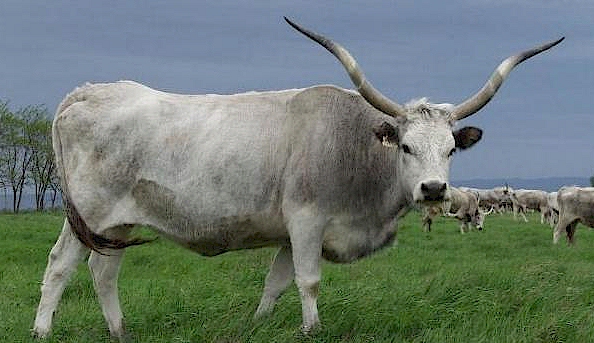Hungarian Grey cattle (Hungarian: Magyar Szürke), also known as the Hungarian Grey Steppe, belong to the group of Podolic cattle and are characterized by long lyre-shaped horns and a pale gray coat. They are well-adapted to extensive pasture systems and were formerly raised in very large numbers in the Hungarian puszta; however, in the 20th century they came close to extinction, but numbers have since increased.
From the Middle Ages until the eighteenth century large numbers of gray cattle were raised extensively on the Hungarian plains. Many were driven on the hoof by hajduk for hundreds of kilometers westward to the markets of cities in western Europe to be slaughtered for beef. The principal destination was Vienna, but others reached Augsburg, Auspitz, Nurnberg, Strasbourg and Venice. During the fifteenth and sixteenth centuries, tens of thousands of cattle were exported in this way each year, and in the seventeenth century the number may have exceeded 100,000 per year. The trade was gravely disrupted by the Ottoman invasions, and for some time was also limited by a monopoly granted by the Imperial court to the Landverleger-Compagnia of Vienna in 1622.
Hungarian cattle are documented at Augsburg in a document of 1526. Another sixteenth-century document refers specifically to magnus cornuotes boves Hungaricos or 'long-horned Hungarian cattle'. In the eighteenth century changing market conditions led to a substantial decline in this trade, and the cattle came to be used principally as draught animals.
In 1931 the Hungarian Grey Cattle Breeders' Association was established and encouraged the keeping and breeding of the cattle. However,? World War II disrupted the efforts. There were only 160 cows and 6 bulls on three farms in the early 1960s. Around that time an interest in preserving local breeds emerged.
By 1975, there were only 300 cows left in two herds, but numbers have since increased. The rebound in numbers is partially due to cryoconservation efforts put forth by the Hungarian government. Government subsidies are available to breeders of the cattle. In 2003, the Hungarian Grey supplied approximately 12% of the locally-produced beef consumed in Hungary.
Today, Hungarian Grey cattle are kept mainly as tourist attractions in the Hortobagy National Park and other Hungarian national parks. Small herds may be found in a few other places, e.g. Bocfolde, Western Hungary. These herds serve as gene banks, due to their reported resistance to cattle diseases which affect more highly bred cattle types.
Content and Photo Source: Wikipedia.Org

